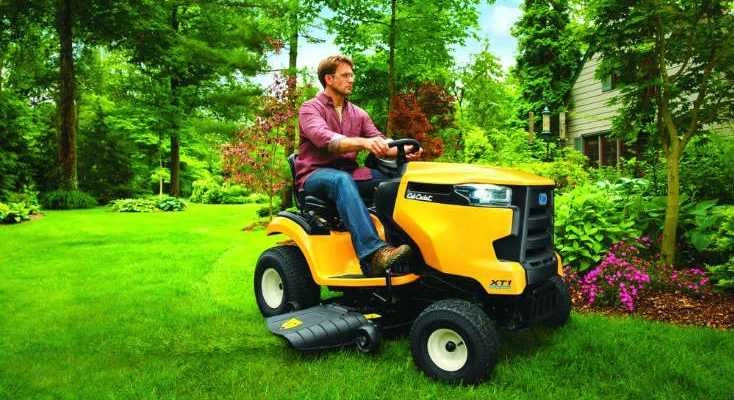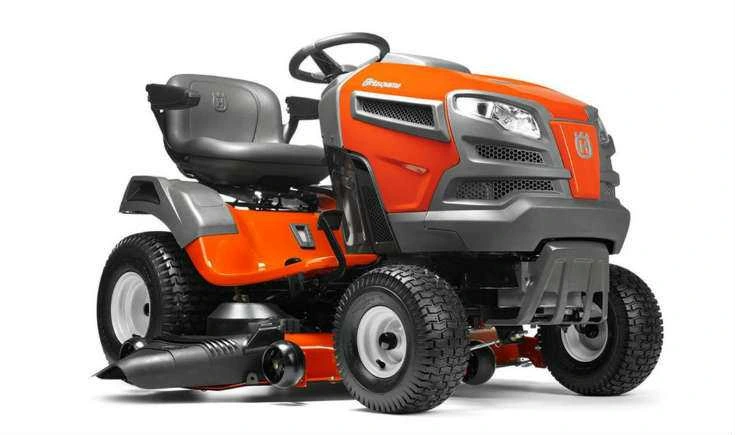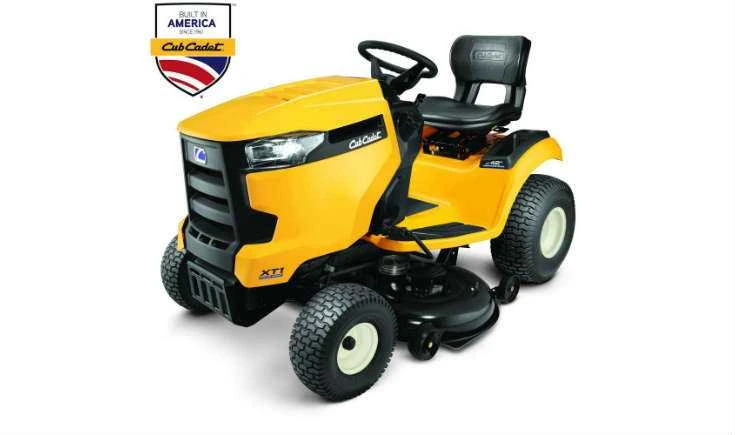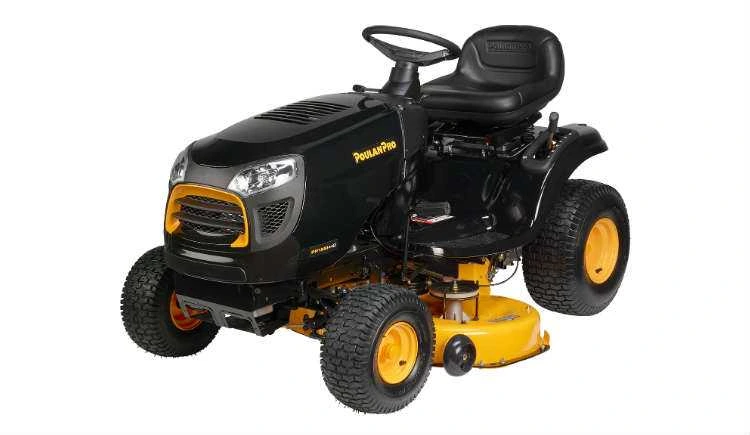Property maintenance can be an unpleasant reality sometimes that we need to deal with as homeowners. A traditional stand behind mower is sufficient for small lawns, but a larger patch of grass can prove relentless to maintain. Larger properties are impossible to properly maintain with this type of equipment. That is when the best riding lawn mower that money can buy becomes a necessity. This will be the subject that we investigate in this article.
Proper upkeep not only provides us with a pleasing view of our lawn, it helps to keep property values high. Untrimmed grass and weeds can also present health and safety hazards. That is why we are tasked with keeping our lawns cut.
Careful consideration is necessary before making the investment in a riding lawn mower. We need to consider the types of riding mowers and their features to best match the equipment to our needs. It is also important to understand the limitations of certain types of riding mowers so that our investment proves capable of taking on our properties’ unique characteristics.
What follows is a general review of four riding mowers, highlighting their unique characteristics and potential drawbacks. This is preceded by information designed to allow us to select the best riding lawn mower possible.
Types of Riding Lawn Mowers
As with most quality equipment, not all riding mowers are the same. A basic riding lawn mower operates and functions in a similar way that a traditional lawn mower works, with the major difference being that we are able to sit on top of it as we mow the lawn. They tend to be simple in design and lack the abilities that make other types of riding mowers stand out.
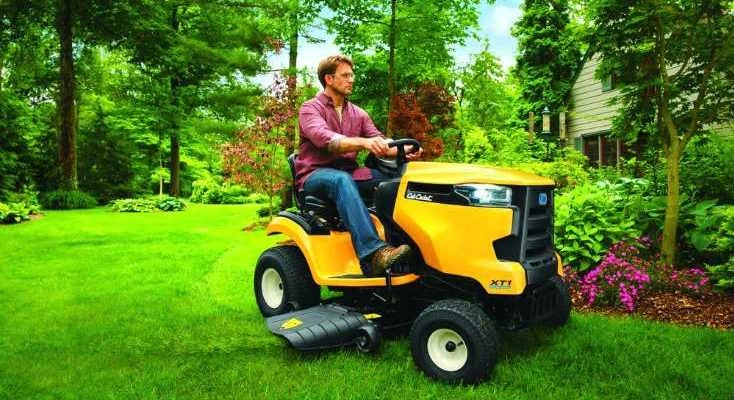
Lawn tractors operate a bit differently, due to the ability of some models to make use of attachments (like small yard trailers) or implements (for edging or mulching grass). This trait makes a lawn tractor the best riding lawn mower in more than one homeowner’s eyes. A garden tractor is a step up from the lawn tractor, offering more power and larger cutting paths. They can make use of more implements such as a plow blade or tiller attachment.
The zero turn mowers differentiate themself with their maneuverability, allowing them to “turn on a dime” as well as higher mowing speeds.
Read more: Our Zero Turn Radius Mower Reviews for 2022!
Finally, commercial riding mowers are built from more durable parts, and stronger engines, and are designed to handle heavy operational hours without breaking down.
What to Look for in the Best Riding Lawn Mower?
Engine Size
The size of the engine is an important consideration, as horsepower determines the output of power it can produce. The higher the horsepower rating is, the greater the amount of work that the riding lawn mower is able to do. This will affect other features including the size of the cutting deck as well as the speed of the blade. Larger engines will also move the riding mower along more quickly and allow it to handle uneven terrain more efficiently.
Front vs. Rear Engine Location
Another engine consideration is location. Engines are located either in front of the rider or in rear-engine designs. Rear engine designs are often slower and have limited accessory abilities. They require less storage space, and heat/noise from the engine is not blasting from in front of the seat. Rear engines also offer better visibility in front of the mower.
Manual vs. Automatic Transmission
Transmission types are a feature that is sometimes overlooked and affects the riding mower experience. Manual transmissions offer the most movement control for the operator. Automatic transmissions offer simple speed control by simply stepping on the pedal of the riding mower. Hydrostatic transmissions use fluid instead of belts to transfer power to the wheels, a feature that provides less maintenance and a smoother riding experience.
Deck Size
The size of the deck is another feature to consider with riding mowers. A smaller deck size of 30 inches could be a good choice for a smaller yard with narrow access points. Taking a step up to a 42-inch deck works well with medium sized properties reaching two acres. The either-sized deck is an excellent choice for moving around trees and working on flat lawns.
Besides offering a larger cutting path, cutting decks nearing four feet are well suited for medium-sized properties with a reach that can cut under bushes with no problems. Cutting decks of 50 inches or more are best suited for properties greater than three acres. Cutting decks of four feet or larger can handle light to medium inclinations and climbs ranging up to 15 degrees in gradient. Cutting decks of 50 inches or more handle medium slopes better and they are able to move over more difficult terrain than cutting decks that are smaller in size.
Cutting Blades
Some of the smaller riding mowers on the market will come with only one cutting blade. This is adequate for smaller lawns and jobs with shorter grass. A larger engine will increase the productivity of a single blade. Riding mowers with two or even three blades are ideal for tackling larger areas and jobs cutting tall grass and weeds.
Most lawnmower blades have a standard lift angle. The airflow created by these blades is great for discharging grass trimmings. A mower blade with a high lift creates an airflow on riding mowers that are most effective for bagging attachments that collect the grass clippings as we mow. Mulching blades hold a more elongated edge that covers most of the blade and is designed to chop grass up into smaller trimmings.
Attachments and Other Riding Lawn Mower Options
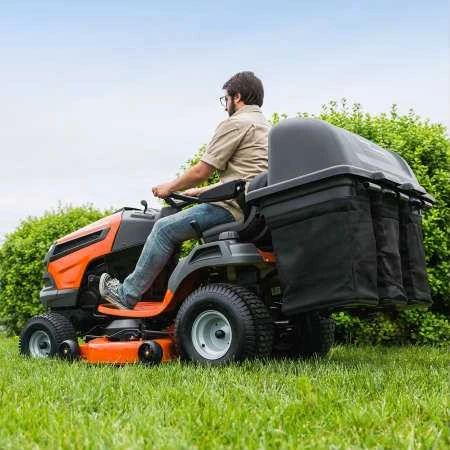
There is a large array of attachments available on the market that can be used on a riding lawn mower. Twin bagger accessories are designed to collect clippings as the mower cuts. This helps to prevent clumps and grass trimmings from scattering across freshly mowed lawns. A mulching kit allows us to break down grass, eliminating the need to collect clippings.
Convenience accessories include carts or wagons that can be towed behind a riding mower. These add-ons are great for moving heavy loads around our properties. Another creature comfort is removable cabins. They provide shade from summer’s hot sun and protection from snow or wind. Speaking of snow, a snow-blade attachment will allow us to take advantage of a riding mower during the winter months.
Specialized accessories do exist such as a snow thrower. Snow blades and throwers are ideal attachments on properties that receive deeper snowfall over the winter. For smaller farms, a sprayer attachment can eliminate a lot of hassle when tending smaller crops. A rear attaching seed spreader offers similar benefits as well.
Comfort Features
Features designed to make the job more enjoyable are often overlooked when considering a riding mower. High back seats or seats with lumbar support can prevent back discomfort while working on larger properties. Those of us who are taller always appreciate designs that offer extra legroom, especially when operating equipment designed for labor-oriented tasks. LED lighting and even cup holders can keep us working when conditions might make us stop.
Most riding mower wheels provide standard handling and performance while driving. These wheels are fine for most yard conditions. On properties with uneven terrain or lots of hills, specialty tires may improve performance. Anti-scalping wheels offer better traction in these conditions.
Turning Radius of the Lawn Mower
For lawns with tight corners or lots of landscaping obstacles, a turning radius can be an important feature. This is less of a concern on larger properties that are wide open. Cruise control would be an unnecessary feature for smaller yards, but a convenient bonus on multi-acre properties. Maintaining a constant speed along large stretches of growth or road might be worth considering.
Is turning radius very important to you? Check out this article about zero radius mowers!
Warranty
Finally, warranties are an important consideration with the money we invest in this type of equipment. It is important to understand the conditions and terms listed to prevent any nasty surprises down the road. Look for a minimum of three years of coverage. Be aware that warranties of four years or more may include limitations on coverage.
Best Riding Lawn Mower Reviews
Troy-Bilt 382cc 30-Inch Premium Neighborhood Riding Lawn Mower 2017 Edition
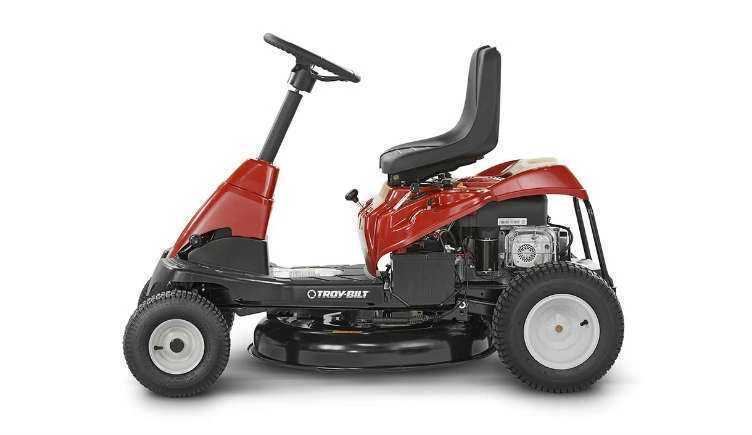
30
Deck size (inches)
382
Engine (cc)
340
Weight (lbs)
Pros
- A smaller footprint provides excellent access and storage
- A tight turn radius offers great maneuverability
Cons
- Smaller deck not optimal for wide open or larger yards
- Rear engine location limits usable accessories
This Troy-Bilt riding lawn mower is powered by a 382 cc auto-choke OHV engine, providing surprising power in a compact design. A 30-inch cutting deck is a side discharge design, offering adequate coverage for a yard up to medium sized. The turning radius of 18 inches provides great maneuverability on lawns with tight corners and lots of landscape obstacles. This riding mower employs a mid-back seat for rider comfort.
The rear engine design lessens heat build up between the operator’s legs during use. The deck height adjustment provides five settings for a variety of tasks. The six-speed transmission and 4.25 MPH speed are notable characteristics of this mower.
48
Deck size (inches)
724
Engine (cc)
481
Weight (lbs)
Pros
- The 48-inch deck is ideal for medium sized yards
- Great traction is provided with anti-scalp gauge wheels
Cons
- Does not have an engine guard
- The front bumper is sold separately
A Briggs & Stratton Intek V-Twin OHV engine supplies this riding mower with 724 CC (4 HP), supplying plenty of power. The 48-inch cutting deck will cover a medium sized property decently. A tight 16-inch turn radius is ideal for cutting around flowers and trees alike. This riding mower comes with a 15-inch Hi-Back seat with an armrest, offering operators comfort while they drive.
Front engine design allows this riding mower to employ a rear bagger or muncher kit. Extras include an hour meter and headlights. Anti-scalp wheels provide great traction, the cutting height can be adjusted to six positions. This mower comes with three cutting blades.
Cub Cadet XT1 Enduro Series 42-Inch Kohler Hydrostatic Gas Front-Engine Riding Mower
42
Deck size (inches)
597
Engine (cc)
580
Weight (lbs)
Pros
- 12-position spring assisted deck with lever operation
- Hydrostatic transmission offers a smooth ride
Cons
- Seat accommodates all riders at the expense of comfort
- There is no bumper bar included
Powered by a Kohler Courage SV541 OHV four-cycle engine and supplying 597 CC (18 HP), this riding lawn tractor is rather impressive. The cutting deck of 42 inches provides good coverage on medium to large properties. A 16-inch turn radius provides great maneuverability for this mower. The Cub Comfort Hi-Back seat includes a 10-inch incline, a nice feature to accommodate users of all sizes.
A Tuff Torq K46 Hydrostatic transmission helps to provide a smooth drive. Anti-scalp steering wheel provides excellent grip where other wheels might slip. Noted extras include a soft touch cruise control as well as LED High Illumination headlights that aid in working through low light conditions.
Cub Cadet XT1 Enduro Series 42-Inch Kohler Hydrostatic Gas Front-Engine Riding Mower
42
Deck size (inches)
382
Engine (cc)
100
Weight (lbs)
Pros
- Oscillating front axle
- Day use headlights are included as standard
Cons
- A larger footprint limits some access and storage
- Turns feel heavy and stiff
This gas riding mower is equipped with a Briggs & Stratton OHV engine that provides 15.5 HP, providing plenty of power to the rear wheels. A 42-inch cutting deck covers adequately ground and offers access under bushes. The mower offers a cutting radius of 16 inches, a decent feature for medium yards with some obstructions. A 13-inch mid-back seat provides some support to the driver during operation.
Automatic hydrostatic transmission creates smooth speed adjustments on the go. Six cutting height adjustments allow for a variety of trimming applications. This gas powered mower employs two blades for cutting under a floating deck. While the seat offers limited support, it is well padded. A cup holder is included on the fender.
Riding Mower Safety
Safety is of paramount importance, and it all starts with the operator manual. We need to understand how our riding lawn mower works. Any special considerations that are unique to the riding mower itself will be highlighted. Operations safety includes protecting ourselves and others. Prevent animals or children from getting close while cutting, and wear clothing and gear that will protect your skin and eyes from branches, debris, or the sun.
Make sure to check the yard and clear any objects before cutting begins. This will help to prevent running over something that can damage the riding mower, or more importantly, ourselves while we work. If something was missed during the walkthrough, take the time to stop the engine and remove the item. Spending a little time will cost less than an expensive repair bill or hospital visit.
Keep in mind to always turn the motor off when the riding mower is not in use. This includes instances when we need to operate gates or remove obstacles in front of us. Turn off the engine before cleaning of fixing it. Remember that hot engines will burn skin instantly.
Practice
Always practice safe driving with the riding mower. Keep an eye ahead of the mower, at least three to four feet, in order to prevent any nasty surprises. Mow during the daytime if possible, and if work must be done in low light conditions use LED headlights. The only way to avoid hazards is to see them ahead of time.
Operate the riding mower on dry grass if possible and remember that moist grass or mud can affect the blade or can cause the mower to get stuck. Be careful when driving on hills or inclines. It is safe practice to mow up and down a gradient instead of across it. This helps to prevent the riding mower from tipping over.
Conclusion
Important to consider what type of riding lawn mower may or should be purchased. Certain design styles allow for easy access to all parts of the property, while other designs may limit access. These same elements can influence where the riding mower is stored as well. Additional accessories must also be calculated when determining storage space.
Matching riding mower features to the needs of a yard is also important. A smaller deck may suffice for compact spaces, but it can also make for more passes across larger lawns. On a property with tight corners and many landscaping obstacles, a larger cutting deck may prove too cumbersome. If the riding mower will be used for work outside of cutting, the available accessories for the job must be considered before purchase.
Engine power, transmission type, and blade characteristics affect the mowing experience. A few adjustments may suffice on a flat property, but they can be crucial on uneven terrain. We hope that the riding mowers reviewed will stimulate further research. We hope this article will help find the best riding lawn mower!
